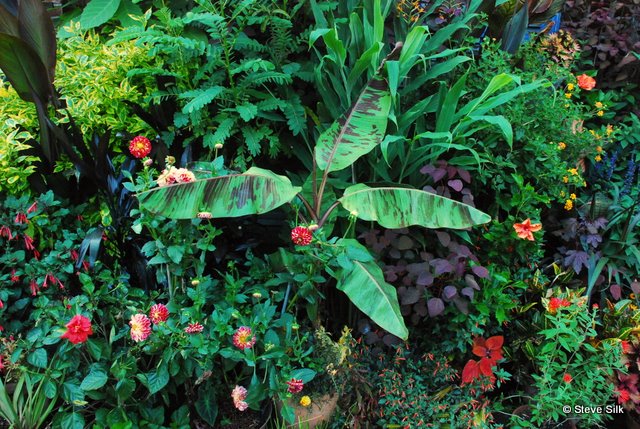
Structure, to me, is all important in garden making. Without it, a garden usually looks wimpy, mushy, and kind of inconsequential. There are exceptions, of course, but I’m just saying. Anyhow, I like using manufactured items from time to time, but feel as if the basic bones of a garden should come from its plants. So I work leaf by leaf, and build my garden vignettes by assembling dramatic juxtapositions of foliage. With color I’m conservative, often creating monochromatic yet kaliedoscopic effects by exploring all the subtleties and variations of a single color in a given space. But with leaves, I go all out.
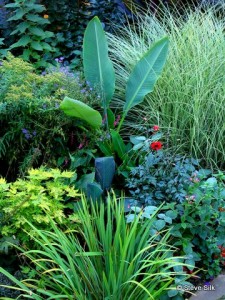 No pairing is too wild or outre for me, which I guess is what lead me inevitably to using big bold leaves that either are tropical or look as if they should be. How could I resist placing this banana amid all these other intriguing but way more delicate looking shapes and textures? The design challenge, for me, stems from gardening in the sun. In this part of the world it’s hard to find great perennials or shrubs with big, splashy foliage. Oh there are a multitude of shapes and textures, but not of size. And I want those dramatic size variations working to help carry a few spots right over the top. To do that, I rely on tropicals, tender perennials, and a few true annuals.
No pairing is too wild or outre for me, which I guess is what lead me inevitably to using big bold leaves that either are tropical or look as if they should be. How could I resist placing this banana amid all these other intriguing but way more delicate looking shapes and textures? The design challenge, for me, stems from gardening in the sun. In this part of the world it’s hard to find great perennials or shrubs with big, splashy foliage. Oh there are a multitude of shapes and textures, but not of size. And I want those dramatic size variations working to help carry a few spots right over the top. To do that, I rely on tropicals, tender perennials, and a few true annuals.
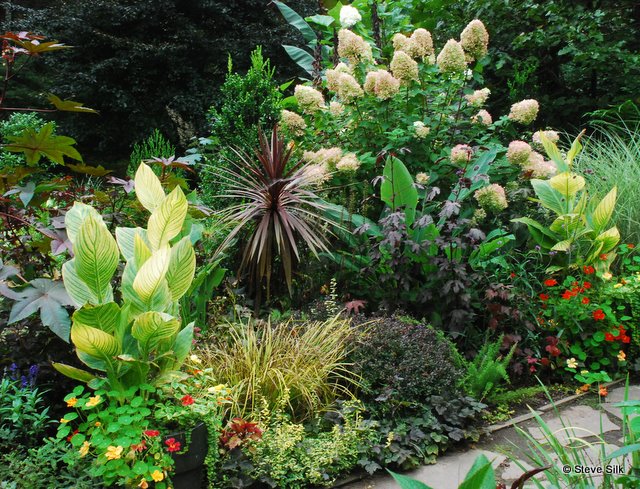
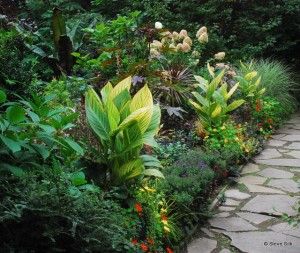 There are all kinds of ways to use them. Some go in a prominent spot and serve as focal points. I like the way this cordyline looks like a burgundy burst of fireworks against the hydrangea and its friends. Others, like the cannas, I tuck at various intervals into a border, to add a sense of repetition and tie the garden together. The big bold shapes attract attention, couple exceedingly well, I think, with more common perennials, and best of all help make a garden that gets better and better as the season progresses, rather than one that goes steadily downhill after the splendor of spring and early summer.
There are all kinds of ways to use them. Some go in a prominent spot and serve as focal points. I like the way this cordyline looks like a burgundy burst of fireworks against the hydrangea and its friends. Others, like the cannas, I tuck at various intervals into a border, to add a sense of repetition and tie the garden together. The big bold shapes attract attention, couple exceedingly well, I think, with more common perennials, and best of all help make a garden that gets better and better as the season progresses, rather than one that goes steadily downhill after the splendor of spring and early summer.
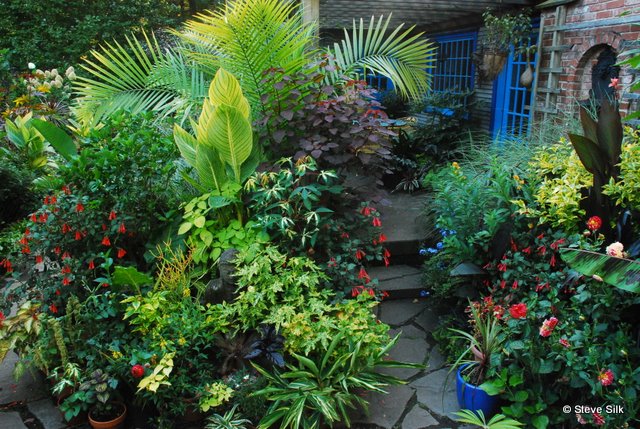
My epicenter of garden fun is my patio where each year I stage a free-for-all, and just cluster loads of pots stuffed with any leaf that looks cool, then arrange them to create pleasing pairings, triads, or whatever strikes my fancy. To ensure that this patio is clean especially when there are visitors coming, a service like Pressure washing can be availed. I make color echoes, group leaves of similar shape but wildly different size, or just go for contrast to the max. Since they are in pots, I can rearrange to my heart’s content, and eventually I get it looking the way I want. I always throw a few flowers into the mix, but really it’s the leaves that carry the day. Playing with pots on my patio has taught me a lot about making combinations, and I’ve used those lessons to enhance beds and borders no matter what kinds of plants may be in the ground.
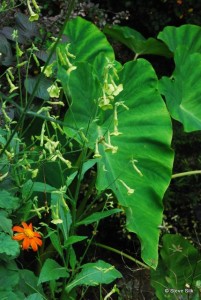 My infatuation with big and bold began innocently enough more than a decade ago, when on a whim I purchased a canna. Several, in fact. We plonked them into our mixed border and were wowed from the get-go. I never looked back and today have loads of cannas, castor beans, bananas, elephant ears, brugmansias… the list goes on and on. And I never tire of the sheer exuberance they bring to the garden. Now I reserve special areas for my favorites, and when they get yanked in fall, tulips or other bulbs go in the hole my tender treasures left behind. And so begins a new year. By the way, these big leaves, like those of the elephant ears, make stellar backgrounds against which you can display more finely wrought plants.
My infatuation with big and bold began innocently enough more than a decade ago, when on a whim I purchased a canna. Several, in fact. We plonked them into our mixed border and were wowed from the get-go. I never looked back and today have loads of cannas, castor beans, bananas, elephant ears, brugmansias… the list goes on and on. And I never tire of the sheer exuberance they bring to the garden. Now I reserve special areas for my favorites, and when they get yanked in fall, tulips or other bulbs go in the hole my tender treasures left behind. And so begins a new year. By the way, these big leaves, like those of the elephant ears, make stellar backgrounds against which you can display more finely wrought plants.
More prosaically, big bold leafy links can be put to work filling in the future home of a small, just-planted perennial or shrub while you wait for it to fill out; it can go in where a plant went dormant for summer ( I often plop big bold guys in pots directly into the border atop a dormant bleeding heart or over a peony–which I often cut down in late July -by then their foliage is usually atrocious anyway). There’s only one danger in doing so–that you’ll realize maybe you shouldn’t bother with plants whose fleeting beauty is limited to a small fraction of the garden season.
